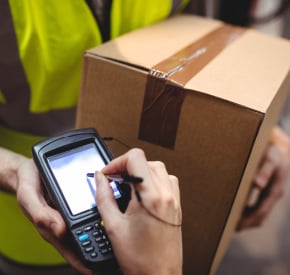
Safe connectivity for lone worker management
Monitor and support the wellbeing of a remote workforce.
What is lone worker protection?
Energy companies often employ a large number of service engineers to install, maintain or repair assets in the field. Whether travelling nationally/locally or working in potentially hazardous environments, lone workers may be at risk. A lone worker solution provides those working remotely or alone with the ability to raise alerts, contact an Alarm Receiving Centre (ARC) and/or request emergency assistance if required.
Lone workers typically have access to a device or app that they can use if an incident occurs. A fully managed lone worker solution enables organisations to protect their staff and ensure their wellbeing, as well as providing much needed reassurance and security to individuals themselves.

The growth of lone worker protection
It is estimated that there are between six to eight million lone workers in the UK for whom connectivity is essential. Lone working is a key part of the job role for many employees in the energy sector who face significant daily risks with large numbers of engineers working with dangerous elements, often on their own.
There is now a wide range of hand-held gadgets, fobs and apps available to provide a much needed lifeline. These devices can be used to raise an alarm and request assistance in the event of an incident, but the latest functionality goes above and beyond a simple panic button. IoT is enabling locations and activities to be logged, with monitored check-up messages if required. While fall detection means it is now possible to automatically recognise if an employee has fallen or been knocked down.
The advent of IoT brings devices, systems and enriched data together to better protect lone workers and help organisations meet their duty of care. The added benefit of real-time information sharing means businesses can gain even greater levels of visibility of lone workers. And lone workers themselves feel fully protected and supported.

Why cellular connectivity for lone worker solutions?
Global network coverage
For global IoT deployments, cellular connectivity is widely considered the most logical and reliable connection option. There is no need to build new infrastructure nor add additional network gateways to support remote deployments. Connectivity is via the cell towers that are already in place. This already tried and tested infrastructure, also provides the added benefit of cellular roaming. For solutions that may either be deployed to an unknown spot in the world or move frequently between regions, a cellular provider with multiple mobile network operators (MNOs) would be a sensible option.
eSIM
Deploying cellular connected devices around the world can be complex particularly with large scale projects that need to connect in different countries. eSIM can help. eSIM or eUICC refers to the over the air re-programmability of IoT SIMs enabling them to connect wherever they are in the world. It brings significant commercial and technical advantages for large scale deployments and applications that need a future proof connectivity solution. eSIM provides an insurance policy. It avoids single vendor lock-in, counteracts permanent roaming restrictions and allows for profile switching for commercial, technical or locational reasons. Without the need to physically swap out SIMS which can be an expensive process. eSIM can simplify the whole supply chain for IoT applications. Beginning with manufacturing, using a single SIM component for all devices and the option to embed the SIM or chip into the device on the production line and provision it later.
Failover
Cellular networks are inherently secure and resilient. Outages are not frequent events but they can happen. Downtime can create significant issues such as loss of revenue or reputation, financial penalties or insurance risks, and in some instances health and safety implications. An ultra-high availability solution lets the SIM detect and manage outages with minimal development overheads in the device or Cloud software. The SIM will operate independently of network control and initiate failover and fall-back automatically.
Supporting always-on two-way communication
Unsteered Multi-network SIMs work with all networks and will always connect to the strongest signal, making them the best option for lone worker connectivity.
Safe from outages, they provide the always-on reliable two-way communication lone workers need to stay safe—as well as the value-added services organisations require. Multi-network SIMs are fully managed, with usage alerts and portals that put organisations in complete control of connectivity. Furthermore, whether you have 100 SIMs or 1000, 100mb or 10GB, data pooling, static IPs, and automatically adjusting tariffs can all be added to create bespoke lone worker connectivity solutions tailored to business needs.
Low Power Wide Area Network
As the title implies, Low Power Wide Area Network (LPWAN) technologies use very low power to provide long-range cellular connectivity. LPWAN technologies use a small portion of the mature and reliable LTE bandwidth to provide connectivity that’s ideally suited to devices that rely on battery technology to function.
Historically, a significant limitation for cellular adoption has been power consumption and battery life (or lack 0f!). LPWAN protocols like LTE-M and NB-IoT make it possible for cellular IoT modules to not only save power when not in use, but to also transmit relatively small amounts of data with minimal power usage.
Both LTE-M and NB-IoT are designed to offer years of operation from a battery-driven power source. Since data throughput is limited, simpler signal modulation schemes and less complex radio modems are needed, leading to diminished power requirements. Advances in wake/sleep modes on modern hardware only contribute to these benefits.
LPWAN cellular options like LTE-M and NB-IOT which help improve battery life across devices are often the primary choice for lone worker devices.
Security
Cyber security risks are a reality. It is essential to keep the gateway secure and create private connections to the Cloud. On-SIM technology and mobile core network services, resolves IoT device identity issues, enables dynamic scalability and provides defence against spoofing of IoT devices, ransomware events and unauthorised device access to network and Cloud services.
Since cellular networks use SIM cards for authentication, it’s exceedingly difficult to spoof the identity of a device. SIMs can be pre-provisioned to securely communicate with Cloud Services. Compare this to Wi-Fi: When connected to a public Wi-Fi network, devices are sharing the connection with all other devices on the network. If any individual device has a security concern, all devices are at-risk. Cellular keeps every device separate from every other device, ensuring the security of the data being transmitted.

Empowering lone worker safety
Connexion2, a UK-based leader in lone worker safety solutions since 2003, specialises in device-based mobile communications and workforce management platforms.
Faced with the challenge of consolidating and optimising cellular connectivity critical for their monitoring systems, they partnered with Wireless Logic. This strategic move ensured reliable performance, enhanced connectivity management and delivered cost-effective solutions, supporting tens of thousands of subscriptions.
IoT connectivity solutions for any sector

Our IoT solutions enable precision farming, optimise resources and improve yields through data-driven decisions for smart, sustainable operations.

Our IoT solutions offer remote control, real-time monitoring and automation of wearables, home appliances and digital assets for enhanced convenience and security.

Our IoT solutions enable predictive maintenance, optimise distribution and support smart grids, enhancing reliability and sustainability whilst reducing costs.

Our IoT solutions offer critical data for environmental protection, regulatory compliance and sustainable resource management, fostering a healthier ecosystem.

Our IoT solutions enable real-time patient data, predictive maintenance of smart devices and better treatment outcomes for personalised healthcare.

Our IoT solutions improve efficiency, reduce downtime and enhance quality control, transforming operations into smart manufacturing processes.

Our IoT solutions optimise supply chains, reduce costs and improve delivery accuracy for better reliability and customer satisfaction.

Improve service delivery and operational efficiency with smart infrastructure, real-time data and automation for a safer, sustainable community.

Our IoT solutions optimise stock management, support sales strategies and provide a seamless, personalised shopping experiences.

Our IoT solutions offer comprehensive coverage, improve incident response and enable proactive threat detection, protecting people and assets.

Our IoT solutions optimise energy use, enhance occupant experience and reduce costs for sustainable, intelligent building environments.

Our IoT solutions enable local authorities to improve urban living, through real-time analytics, connected infrastructure and automated services.

Our IoT solutions reduce downtime, improve delivery services and boost customer satisfaction driving innovation and sustainability in transportation.
